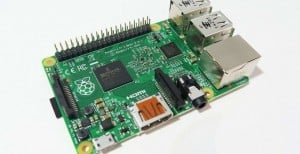Classes have started and you need a project to take your mind off all that homework you already have…. Try Raspberry Pi – it is more than just a yummy dessert!
It’s a small computer – credit-card sized – that is inexpensive and was designed with hacking and computer experimentation in mind. The introduction to Raspberry Pi Projects by Andrew Robinson and Mike Cook, likens learning to use computers with learning to cook – everyone should have those basic skills. That doesn’t mean that everyone will become professional chefs or computer programmers, but it is good to know those basics. Eben Upton developed Raspberry Pi while working with computer science students at Cambridge University. He found that students weren’t “tinkering” with their computers. So he developed an inexpensive – around $25 – computer that is designed to be hacked and used for experimentation. Raspberry Pi is a great way to learn the basics of Linux or Python programming, and electronics.

Want to geocache from the comfort of your car? You can do that with Raspberry Pi! Maybe the only kind of pet you are allowed to have in your dorm or apartment is fish. Trying to maintain the proper water temperature can be tricky. So, make a smart, communicative thermometer to let you know when the water in your fish tank fluctuates to a dangerous degree. You can do it using Raspberry Pi. Or how about making a lamp that creates mood lighting, but can also check your Twitter messages? You can, with Raspberry Pi.
We have resources to help you get started with your Raspberry Pi experimentation. For the reader who has never used it before, Raspberry Pi from the “Teach Yourself Visually” is available. For those ready for a more in-depth manual, check out Mastering the Raspberry Pi. We have books with Raspberry Pi projects and hacks that will walk you through working with both software and hardware, from games like Minecraft to controlling a LEGO robot to creating a one person band.
Piqued your interest? Want to try your hand at using a Raspberry Pi? We have one in the Tool Library! We also have many other tools to help you as you tinker and explore. The lamp that creates mood lighting and checks your Twitter account calls for a multimeter – we have that in the Tool Library, too. Incidentally, the mood-lighting-Twitter-checking lamp is called a “Giraffe Mood Lamp” in Make: raspberry Pi and AVR projects. You’ll have to check it out to find out why! Don’t have a Twitter account yet? We have Twitter for Dummies.
We have what you need to get started with Raspberry Pi – and it could be just the project you need for this weekend!
Resources:;
Hoile, Cefn. 2014. Make: Raspberry Pi and AVR projects. Sebastopol, CA : Maker Media, Inc. Engineering Library QA76.8 .R15 H65 2015
Suehle, Ruth. 2014. Raspberry Pi hacks. Sebastopol, CA : O’Reilly Media. Engineering Library QA76.8 .R15 S84 2014
Wentk, Richard. 2014. Raspberry Pi (Teach yourself visually). Indianapolis, IN : John Wiley & Sons, Inc. Engineering Library AQ76.8 .R15 W46 2014
Robinson, Andrew. 2014. Raspberry Pi projects. Chichester, West Sussex : Wiley. Engineering Library QA76.8 .R15 R53 2014
Gay, Warren. 2014. Mastering the Raspberry Pi. Berkeley, CA : Apress. Engineering LIbrary QA76.8 .R15 G39 2014
Raspberry Pi 2. Lichtenberger Engineering Library Tool Library
Multimeter (Voltmeter). Lictenberger Engineering Library Tool Library.
Other Resources:
Raspberry Pi 2: Six things you can (and can’t) do. February 11, 2015. Information Week.
Build a Raspberry Pi powered joke machine. Maker Media. Date Accessed: August 25, 2015